- Home
- T. Jefferson Parker
Swift Vengeance Page 12
Swift Vengeance Read online
Page 12
Back at the computer I stared at the monitor until the screensaver came on. Rubbed my eyes and yawned. Considered another drink but told the bartender I was fine.
Bring this story to life, I thought. The living have their versions—but what about the dead?
What would they say?
You don’t even know their names.
I wanted names.
I wanted faces.
The Doctors Without Borders page had declined to publish names, nor had other mentions of the attack identified the victims. I went back to the links at the ends of the articles I’d printed, but nothing looked promising.
Change it up, I thought. Come at it another way.
I found mountains of government statistics of both military and civilian deaths in the Syrian Arab Republic. I narrowed to “air strike deaths” and found numbers but not names. I narrowed again to “drone strike deaths” and found the same. I bored an even smaller hole: “medical workers dead in Aleppo,” which took me back to the Doctors Without Borders releases.
The Free Syria group had its own version of the drone strike outside IH-One, but it listed none of the dead by name. Again, victims’ nationalities—Syrian, French, German, and Italian—were noted. Then something caught my eye, a link hidden in a thicket of them at the end of a Free Syria release:
Martyr Statistics—Published by the Syrian Revolution Martyr Database http://syrianshuhada.com.
I hit the translate button and watched English replace the Arabic writing.
On the home page was a map of Syria and a “martyr count” by province. The site listed a staggering 151,888 martyrs killed in Syria through April of 2016—before the bloody siege of Aleppo. I thought about that number for a moment, knowing that the number of Syrians forced to leave their homes was many times more.
On the left side of the home page was a long table of contents. My heart sped up:
MARTYR COUNTS BY GENDER
MARTYR COUNTS BY CIVILIAN/MILITARY
MARTYR COUNTS BY PROVINCE OF DEATH
MARTYR COUNTS BY CITY OF BIRTH
MARTYR COUNTS BY NATIONALITY
STATISTICS OF CHILDREN MARTYRS
STATISTICS OF FEMALE MARTYRS
STATISTICS OF MARTYRS FROM CHEMICAL AIR BOMBING
And on and on. I clicked on “Martyr Counts by Week,” found that forty-four civilians had died in the city of Aleppo the week of 4/24/2015. Of these, eighteen had died in “Bombardment by air.”
Next I went to “Martyr Counts in Aleppo City by Neighborhood” and found that Farafra—home of humble IH-One—had been the neighborhood of death for nine martyrs the week that the Headhunters had drawn down on Zkrya Gourmat.
My heart sped up, solid and eager.
On a separate sheet of paper I wrote down their Martyr ID numbers, then began in alphabetical order.
Monique Alaly was a twenty-two-year-old French woman with a black hijab and a winning smile. She was listed as a volunteer medical worker. A short video showed her in a classroom, teaching science to a roomful of girls.
Mhood Amin was a Syrian doctor. Male, no age given and no picture or video.
Ibrahim Azmeh was a forty-nine-year-old Syrian doctor with a sharp, ascetic face and straight black hair. In his video, the doctor sat in an outdoor café in what looked like Damascus, smoking a cigarette and looking calmly at the camera.
Noor Mofq was a forty-year-old Syrian nurse, female, no photo or video.
Dieter Njar was a thirty-year-old German volunteer medical worker. In his dark-framed eyeglasses he looked scholarly. The short video showed him kicking a ball down a soccer field.
Nurse Ahmad Radhah was Syrian and twenty years old, his face plump and cheerful. He sat astride a scooter on a dusty city street, his helmet too small and riding high up on his head.
Nurse Ramy Salim was bearded, twenty-eight, Syrian.
Omar Soad was an Italian volunteer worker, mustachioed and handsome. The video showed him smiling, his arm around a young woman. No age given.
Syrian volunteer Nady Warim was eighteen and wore a light-colored hijab.
I printed each martyr’s page, read them carefully, then again. I logged off syrianshuhada.com and on to my IvarDuggans site, on which I spent the next hour searching the nine last names. I set the search parameters for people eighteen to sixty years of age, hoping to snag siblings and/or parents who might have come to the United States. Only four of the last names came up nationally: one hundred fifteen Alalys, two hundred forty-five Azmehs, eighty Radhahs, and three hundred eighty-seven Salims. I ran Gourmat also: seven hundred thirty-two across the nation.
Making a risky assumption, I narrowed the search to California residents. This cut the list by roughly two-thirds. When I cast an even smaller net—restricting the search to five years or less of residence in the state—my third was halved in a keystroke. Which left me two hundred thirty-four men and women living in California who may or may not have been related to one of the ten people who died in the Headhunter drone strike on IH-One on April 22, 2015.
More risky assumptions landed me one hundred seventy-one people in Southern California: thirty in greater Bakersfield and sixty-six in San Diego County.
Next I cross-referenced all ninety-six individuals through the “known associates” search. As I expected, many with the same last names were family. Google Maps allowed me to see their homes and neighborhoods. I found clusters in Northeast Bakersfield and in El Cajon, east of San Diego. I wondered how many were on the walls of Taucher’s JTTF office.
Choosing four of the San Diego names at random, I printed out home address histories, aliases, email addresses and phone numbers, vehicle ownership, fictitious business names, and evictions. And again, I found familial interconnections where I expected to. The information came forth quickly. IvarDuggans was worth its salt on the easy things.
But it took me another full hour to search the criminal records of the four lucky people I’d chosen. The IvarDuggans criminal and court records databases are notoriously slow. I longed for my former Sheriff’s Department access to the state and federal agencies, the best data often being the bones the FBI threw your way.
By then it was after two o’clock. I stood and stretched, knowing that IvarDuggans didn’t have the tools to do the hard labor of separating terrorists from innocents. But I knew who did.
“Up kind of late, aren’t you, Joan?” I asked.
“Ford? Has something happened?” By the time she’d finished asking the question, her voice had gone from dull to sharp.
“We need to run some names.”
“It’s two fifteen in the morning, you ape,” she said. “Learn some manners.”
“Listen.”
I told her about the Headhunters’ accidental catastrophe at IH-One in Aleppo. How that piece of bad luck had cost nine innocent lives. How Kenny Bryce’s conscience had clamped on and shook him like a bulldog for years. Lindsey’s, too. And probably Voss’s.
Taucher listened but said nothing.
So I took a leap of faith over miles and years, landing on the eerie sense of familiarity and blame that Caliphornia’s threats contained. What if Caliphornia had originally been forged in that misbegotten air strike? So much of what we knew about him pointed to Middle Eastern roots and culture. What if he was a relative or friend of someone the Headhunters had killed? A brother, even. A father?
In the presentation of my thesis I began to see its wobbly structure. What if what we thought we knew about Caliphornia was invented as distraction? Were we being played? As if to strengthen my premise, I told Taucher the search criteria I’d used. I sounded exhausted even to myself. Doubted that I was making sense. Doubled down with false bravado.
“I’ve got thirty names in Bakersfield that need to be checked,” I said. “Sixty-six here in San Diego. Run them for me, Joan. I need this. I cut the
list from seven hundred.”
Silence from her, the slot machine whirring. “You were right this morning about risk and trust.”
Heading into a storm you know is there.
I still wasn’t sure what had brought those words out of me as the rain poured down on us. Part of it was seeing the Grand Hyatt, where I’d first laid eyes on Justine Timmerman in a similar, spectacular storm.
But the bigger part was a storm of a wholly different kind—Caliphornia and his bloody Thunder. I had felt him down on the waterfront in the rain. A force of will. Gathering himself right here in my state and my city. For an attack against my own.
“Okay, Roland. Email the names to me. I can search phonetically, but it helps when the names are spelled correctly and consistently. I spend too much time trying to account for the quirks of Arabic and Farsi.”
“I owe you.”
“I’ll never get back to sleep now,” she said.
“You can brew up some coffee and watch the sunrise.”
“I’ll be in my office hours before the sun comes up,” she said. “I usually am. Doing more important things than watching the sun do what it always does.”
I heard her quick wispy laugh, then the line went dead.
* * *
—
Taucher returned my wakeup call at five fifty, just as the sun was pushing the darkness from my bedroom. I’d fallen asleep on the bed with my clothes on.
“One of the victims of the drone attack on IH-One has relatives living in California,” she said, speaking fast. “Dr. Ibrahim Azmeh was survived by nine children. Three live in France, three in Syria, and three live in Los Angeles, where they were born. Two brothers and a sister. We’ll interview them tomorrow afternoon. The older brother filed a State Department complaint after his father’s death and got twelve thousand five hundred U.S. dollars in condolence pay. He’s not on our radar and don’t ask me why. Pick me up by the elevator on the third level of the Horton Plaza parking garage, tomorrow, noon sharp. You can drive. I hate the L.A. traffic.”
“Good morning, Joan.”
“There’s no such thing as good, Roland,” she said. “Rasha Samara was in Bakersfield the day Kenny Bryce died. He bought an Arabian horse for two hundred and forty thousand dollars.”
I hadn’t even formulated a reply by the time that Taucher, master of the short good-bye, was gone again.
I stood in the kitchen waiting for the coffee to percolate, two hands on the counter, looking out at the grainy light that was trying to buoy the day. I’d been up most of the night and maybe that’s all it was, but Taucher’s dire pronouncement had moved me. Moved me from doubt and melancholy to some rough hybrid of anger and frustration.
There’s no such thing as good.
Thirty-nine years on this planet. Why hadn’t someone told me?
My phone rang and Jason Bayless’s name and number came up.
“Okay, Ford,” he said. “I found her. As you no doubt heard from your little friend. I gave my client your home address and collected a nice bonus I’d worked into the deal. The reason I’m calling is to say that my client is not my client anymore. When I told him that Lindsey Rakes appeared to be residing on your property, he wanted to know the layout of the place, which room was hers, when she was most likely to be home. He tried to hire me to get inside and take photos or video, or maybe fly over a drone. I told him I don’t fly fucking drones. He made a joke about her not needing a place to live for that much longer. Actually laughed. Ford, I didn’t like this guy from the start and I like him less now. I don’t know what your Lindsey has gotten herself into, but this little fart is bad news. Just my guts talking.”
“What’s his name?”
“Hector O. Padilla. El Cajon.”
No such thing as good?
“Talk to me, Jason.”
“When he hired me he said he was Lindsey’s cousin,” said Bayless. “Later he said Lindsey and he had been married once and he was paying child support and had to talk to her. He gave me those two different stories and I wasn’t even pressing him. Then he said Lindsey was important to his boss. Boss? Who exactly am I working for here? I had a bad feeling about him. I realized no, I can’t do any more work for this shitbird.”
“Where did you leave it with him?” I asked.
“Professional and cordial.”
“Did you talk in person?”
“Once. Then Telegram, mostly. Why?”
“I don’t know,” I said. “More bad feelings. I get ’em, too.”
17
AN HOUR LATER Burt’s dog-breeder friend, Bruno Zacardi, came up the drive in a mud-splattered white crew cab and parked in the sun of the barnyard. The company logo on the truck was a bronze-colored Roman battle shield with an armored dog in the middle. Zacardi was arched over the top of the shield in ancient Latin letters and Cane Corsos at the bottom. There was a phone number and a Riverside, California, address.
As Lindsey, Burt, and I walked down to greet them, I could see the head of a large dark dog looming over the people in the front seat.
Bruno dropped from the vehicle and landed lightly, a small man with black hair sprouting out from under a newsboy’s cap, and a thick black mustache. A woman worked her way down from the passenger side. She was large and blond, wearing overalls over a blue plaid shirt, and black rubber mud boots almost to her knees. She slung a red backpack over one shoulder, then set her fists firmly on her hips as she looked around.
“That’s his wife, Rose,” said Burt. “And little Zeno there in the back.”
As we crossed the barnyard toward the truck, Bruno motioned for us to stop. He and Rose continued forward to meet us well away from their truck, in the backseat of which Zeno’s massive head and sharply cropped ears presided in keen stillness. He looked to be a pale gray. Burt introduced us and we shook hands all around.
Then a moment of silence as Lindsey stared at the dog in the truck. She stuck her hands into the pockets of her red Navajo blanket coat.
“The dog,” said Bruno. “At first he can be distracted by so many people. We leave him for a moment of thought. Lindsey, you are very lucky to have Zeno. You will be safe. You will come to love him very much. And of course he will be devoted to you, too.”
“Is he really as big as he looks from here?” she asked.
“Seventy-five kilos. Large for his breed,” said Rose. Her accent was not as pronounced as Bruno’s. “But the Italian mastiff is not a big mastiff. They are trim and athletic and extremely focused on their loved ones. They descend from the Molossers, Roman war dogs that are now extinct. Then the Italian mastiffs themselves almost became extinct. Our lines all derive from stock in southern Italy—from Basilicata, Campania, and Apulia. It has been our life work to preserve them. As you probably know.”
“Yes, I’ve read about them,” said Lindsey. “And about you.”
“The old Molossers were the best war dogs out there,” said Burt. “The Romans liked to starve them before battle, then set them loose on the enemy. Some riveting accounts about Roman legions employing the war dogs in Sardinia. Dragging the locals out of caves and such. Recommended reading.”
Bruno smiled largely. He had a wide nose that seemed to divide his mustache. With his accented English, newsboy cap, and too-small wool sweater, Bruno could have just arrived at Ellis Island. “Burt, you forget Cane Corsos’ great loyalty and love. Be careful to not change Lindsey’s mind!”
“No chance of that,” said Lindsey. “Can I meet him now?”
Bruno looked to Rose, who set her fists on her spacious hips again as she turned to survey the pond and the countryside beyond. Her fine blond hair lifted in the breeze. “This is your land, Mr. Ford?”
“Yes.”
“So there’s no sudden arrival of humans or dogs?”
“Very little. It’s fenced and posted.”
“We
’ll use it for the imprint,” she said. “It will work well, Bruno.”
Bruno smiled. “Yes, Rose. You come with us, Lindsey. But—with respect, Mr. Ford—you and Burt wait here until I come back. It will not be long. The imprint must begin naturally and happen at Lindsey’s and Zeno’s pace.”
Bruno took Lindsey’s arm in one hand and Rose’s with the other and guided them back toward the truck. The women towered over him.
They stopped about ten feet short of the driver’s-side door. Bruno was talking to Lindsey, gesticulating with his small stubby hands, but I couldn’t make out his words. Lindsey nodded, then nodded again. Rose—taller even than Lindsey and half again as wide—looked at Lindsey with what looked like a critical eye. I could see the dog’s huge block of a head and his eyes glimmering far back in the truck.
Bruno’s hands and arms flew as he explained. Lindsey nodded along, bent respectfully to Bruno’s shortness. Then Rose strode three long steps to the back door of the crew cab and swung it open with a sharp command. She stepped back and tapped her thighs with both hands and Zeno launched to the ground.
What struck me first were his large sculpted muscles and imposing head. Sleek bulk. He looked metallic. Even from here I could see that his eyes were the same light gray as his brindling. He had a small white triangular blaze on his chest. With his stubby tail wagging, he circled Rose happily, nose to the air, then nose to the ground. He looked very heavy, though not tall at the withers. But light on his huge feet. When he bumped Rose’s legs I could see his formidable weight and strength shudder through her.
“A gray-masked formentino brindle,” said Burt. “Light gray brindles on fawn, leaning toward cream. Very striking. The dog is classic Cane Corso—ears cropped equilaterally to stand erect at all times. Tail docked at the fourth vertebrae. The lower lip hanging below the jawline. As Rose pointed out, this breed was nearly extinct in the late 1970s. A few families, such as the Zacardis, rescued them. I stayed with Bruno’s uncle Anatoly and his family in Basilicata one summer long ago. Fantastic people.”

 The Jaguar
The Jaguar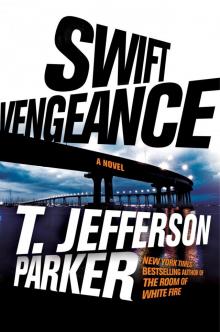 Swift Vengeance
Swift Vengeance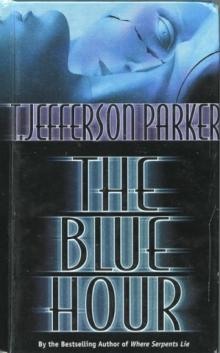 THE BLUE HOUR
THE BLUE HOUR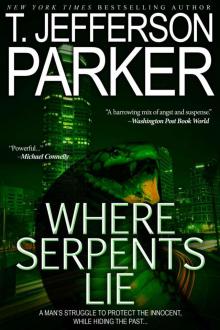 Where Serpents Lie (Revised March 2013)
Where Serpents Lie (Revised March 2013)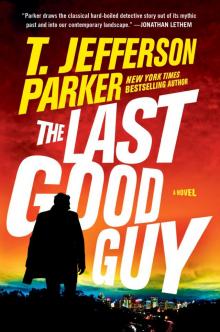 The Last Good Guy
The Last Good Guy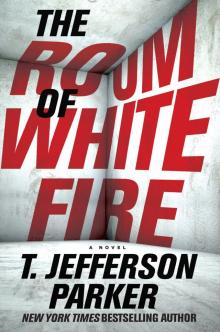 The Room of White Fire
The Room of White Fire Then She Vanished
Then She Vanished The Border Lords
The Border Lords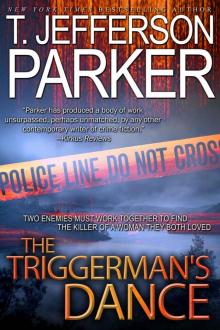 The Triggerman's Dance
The Triggerman's Dance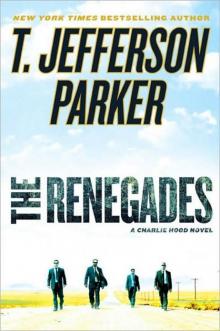 The Renegades
The Renegades Silent Joe
Silent Joe Iron River
Iron River Red Light
Red Light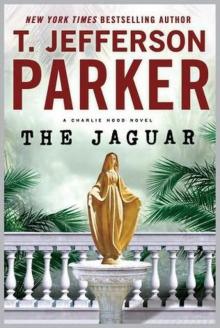 The Jaguar ch-5
The Jaguar ch-5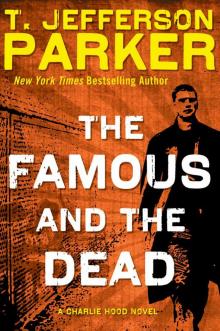 The Famous and the Dead ch-6
The Famous and the Dead ch-6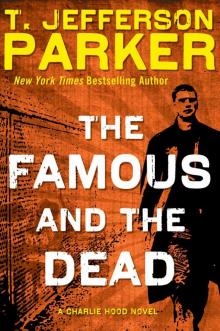 The Famous and the Dead
The Famous and the Dead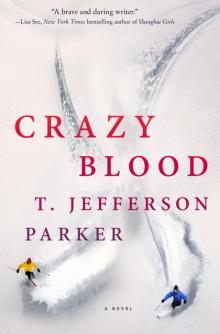 Crazy Blood
Crazy Blood Black Water
Black Water The Renegades: A Charlie Hood Novel
The Renegades: A Charlie Hood Novel Full Measure: A Novel
Full Measure: A Novel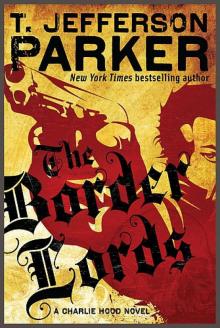 The border Lords ch-4
The border Lords ch-4 California Girl
California Girl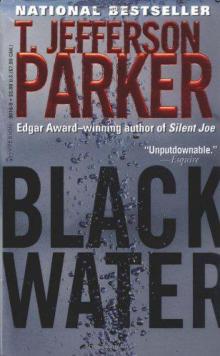 Black Water mr-3
Black Water mr-3 Little Saigon
Little Saigon L. A. Outlaws
L. A. Outlaws The Triggerman Dance
The Triggerman Dance Amazonia
Amazonia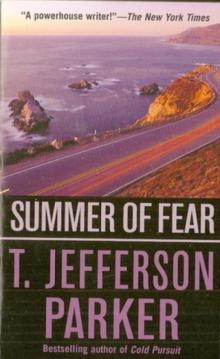 SUMMER of FEAR
SUMMER of FEAR Laguna Heat
Laguna Heat The Renegades ch-2
The Renegades ch-2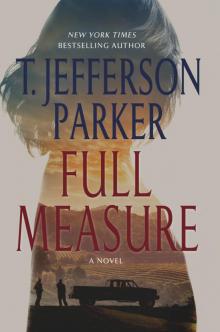 Full Measure
Full Measure